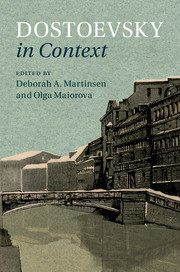Book contents
- Frontmatter
- Contents
- List of illustrations
- Notes on contributors
- Acknowledgments
- Note on citation, transliteration, glossary, and dates
- Chronology
- 1 Introduction: the many worlds of Dostoevsky
- PART I SOCIAL, HISTORICAL, AND CULTURAL CONTEXTS
- i CHANGING POLITICAL, ECONOMIC, AND SOCIAL LANDSCAPE
- ii POLITICAL, SOCIAL, AND CULTURAL INSTITUTIONS
- 9 Russian monarchy and the people
- 10 Empire
- 11 Service ranks
- 12 Education
- 13 Science, technology, and medicine
- 14 Jews, race, and biology
- 15 Suicide
- 16 Children
- 17 Gambling
- iii SPACE AND PLACE
- iv RELIGION AND MODERNITY
- PART II LITERATURE, JOURNALISM, AND LANGUAGES
- Glossary
- Further reading
- Index
- References
11 - Service ranks
from ii - POLITICAL, SOCIAL, AND CULTURAL INSTITUTIONS
Published online by Cambridge University Press: 18 December 2015
- Frontmatter
- Contents
- List of illustrations
- Notes on contributors
- Acknowledgments
- Note on citation, transliteration, glossary, and dates
- Chronology
- 1 Introduction: the many worlds of Dostoevsky
- PART I SOCIAL, HISTORICAL, AND CULTURAL CONTEXTS
- i CHANGING POLITICAL, ECONOMIC, AND SOCIAL LANDSCAPE
- ii POLITICAL, SOCIAL, AND CULTURAL INSTITUTIONS
- 9 Russian monarchy and the people
- 10 Empire
- 11 Service ranks
- 12 Education
- 13 Science, technology, and medicine
- 14 Jews, race, and biology
- 15 Suicide
- 16 Children
- 17 Gambling
- iii SPACE AND PLACE
- iv RELIGION AND MODERNITY
- PART II LITERATURE, JOURNALISM, AND LANGUAGES
- Glossary
- Further reading
- Index
- References
Summary
But suddenly there appeared a radical change in the organization of our best people as well: by decree of the state, all the best people were sorted out into fourteen categories called classes, one higher than the other in a kind of ladder, so that we had precisely fourteen categories of human valor, each with a German name.
(23:154; WD 1: 665)In the course of his reforms, Peter the Great (1682–1725) essentially created a new noble class (dvoryanstvo), one that incorporated not only members of various Muscovite elite groups, but also commoners who could become nobles either through successful service or imperial favor. One thing the members of this group “had in common – and which had no equivalent in the West – was that they held a specified rank in the Table of Ranks.” Peter's Table of Ranks, a list of positions in the military, civil, and court services introduced in 1722, defined the new nobility as a service class (Table 1). Service was to begin at age 15 and continue indefinitely. Compulsory service for nobles was not abolished until 1762 by Peter III. Some nobles retired at this point, but the majority remained in service, which continued to define a nobleman's place in society throughout the imperial period.
The Table of Ranks created a hierarchy within the nobility: in every service category (military, civil, and court), ranks were divided into fourteen classes in decreasing order of importance, one being the highest. Additionally, not everyone who held a rank was a nobleman: civil and court servitors below the eighth class could be (and often were) commoners. By enabling them to be ennobled by ascending the hierarchy, the Table of Ranks introduced more heterogeneity in the noble estate. Predictably, heirs of the pre-Petrine service elite resented the newcomers, whom they perceived as interlopers. Commoners entering the noble class via civil service had particular difficulties, because civil service was given a lesser status in the Table of Ranks from the outset. Finally, many of the so-called new aristocracy (the term coined to designate families that acquired their high status thanks to imperial favor) became far more powerful than some families with a pre-Petrine lineage, which added a particular edge to the latter's resentment of the influential newcomers.
- Type
- Chapter
- Information
- Dostoevsky in Context , pp. 98 - 105Publisher: Cambridge University PressPrint publication year: 2016

